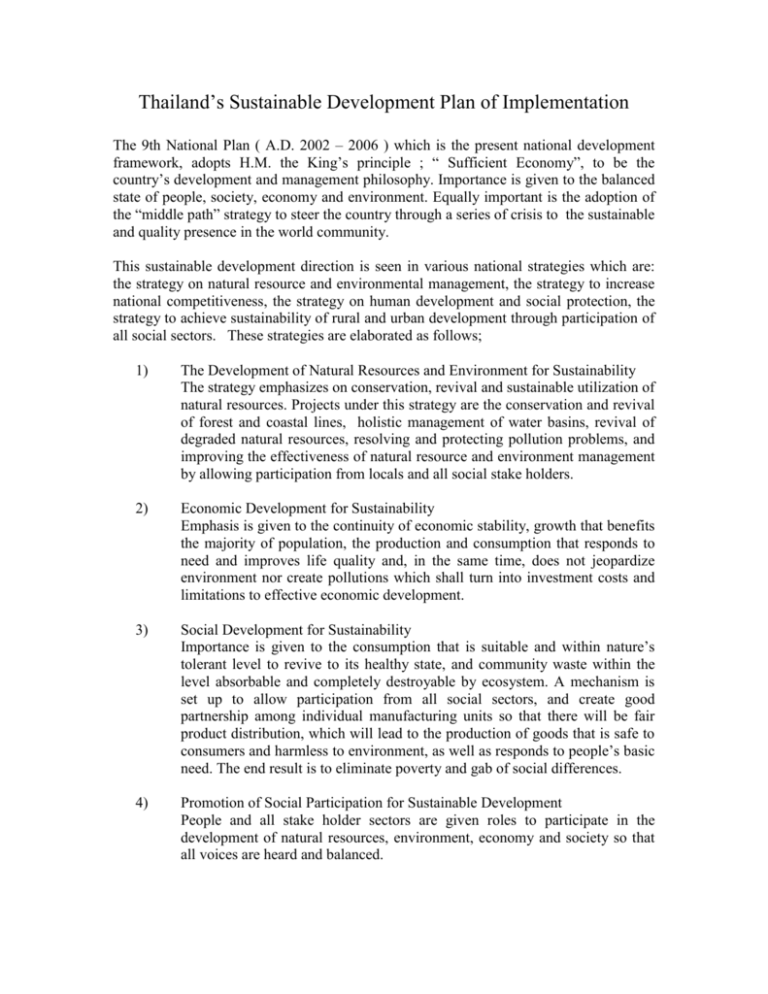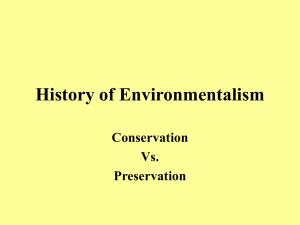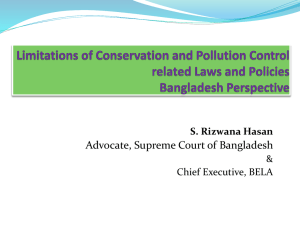The 9th National Plan ( A
advertisement

Thailand’s Sustainable Development Plan of Implementation The 9th National Plan ( A.D. 2002 – 2006 ) which is the present national development framework, adopts H.M. the King’s principle ; “ Sufficient Economy”, to be the country’s development and management philosophy. Importance is given to the balanced state of people, society, economy and environment. Equally important is the adoption of the “middle path” strategy to steer the country through a series of crisis to the sustainable and quality presence in the world community. This sustainable development direction is seen in various national strategies which are: the strategy on natural resource and environmental management, the strategy to increase national competitiveness, the strategy on human development and social protection, the strategy to achieve sustainability of rural and urban development through participation of all social sectors. These strategies are elaborated as follows; 1) The Development of Natural Resources and Environment for Sustainability The strategy emphasizes on conservation, revival and sustainable utilization of natural resources. Projects under this strategy are the conservation and revival of forest and coastal lines, holistic management of water basins, revival of degraded natural resources, resolving and protecting pollution problems, and improving the effectiveness of natural resource and environment management by allowing participation from locals and all social stake holders. 2) Economic Development for Sustainability Emphasis is given to the continuity of economic stability, growth that benefits the majority of population, the production and consumption that responds to need and improves life quality and, in the same time, does not jeopardize environment nor create pollutions which shall turn into investment costs and limitations to effective economic development. 3) Social Development for Sustainability Importance is given to the consumption that is suitable and within nature’s tolerant level to revive to its healthy state, and community waste within the level absorbable and completely destroyable by ecosystem. A mechanism is set up to allow participation from all social sectors, and create good partnership among individual manufacturing units so that there will be fair product distribution, which will lead to the production of goods that is safe to consumers and harmless to environment, as well as responds to people’s basic need. The end result is to eliminate poverty and gab of social differences. 4) Promotion of Social Participation for Sustainable Development People and all stake holder sectors are given roles to participate in the development of natural resources, environment, economy and society so that all voices are heard and balanced. The sustainable development policy and direction does not only appear in the National Economic and Social Development Plan, but there are a large number of policies, plans and measures to manage and conserve the country’s natural resources and environment in an overall picture , as well as segmental. Those already announced into use include the National Policy and Plan to Promote and Conserve Environment B.E. 2540-2559, the National Land Policy, the National Forest Policy and the National Policy on Municipal Waste. And in the light that problems of natural resource and environment are largely of a local level, there are also many local level plans and policies to handle them. These plans are; for example, the conservation and improvement plan of old town environment and the use of fiscal and financial measures as a key driver to conserve and manage natural resource and environment. In the aspect of law, there is an announcement of the Act on the Promotion and Protection of National Environment B.E. 2535 which aims to manage and protect the nation’s environment in such a manner that it nurtures and does not obstruct the country’s socio-economical development. Additionally, the natural resource and environment issue has been incorporated into many important laws which have followed at a later stage i.e. the Constitute of the Kingdom of Thailand B.E. 2540, the Act Promulgating Local Administration Plan and Decentralization Process B.E. 2542. The latter act particularly emphasizes on the right and duty of people, private sector and local administrative entity to take part in protecting the country’s environment. There are also the “National Agenda” and key strategies identified under the present government’s administration. Urgent issues that the country is putting effort to achieve are; elimination of poverty, increasing national competitiveness, social capital development, and this paper subject - sustainable development. A sustainable development committee has been set up since December 2002. It is chaired by H.E. the Prime Minister. The Progress of Thailand’s Sustainable Development Although the ideas, policies and plans on sustainable development have been put into continual use for over 20 years, success has been seen on the economic side only. The severity of the unbalanced state of development is apparent from the Sustainable Development Index ( developed by Thailand’s National Economic and Social Development Board - NESDB) and the United Nation’s Millennium Development Goal. The Sustainable Development Index 1.1 The overall economic sustainability index is at a satisfying level. In 2003, the economic index indicated 79.05 % or at a good level ( increased from 66.65 % in 2001 ). The index on economic stability made a satisfying adjustment as well; from 39.51 % in the last year of the 8th Plan to 80.04 % in 2002 and 87 % in 2003, lifting the development level from “need for improvement” to a better level. Unemployment went down to the level before the economic crisis, resulting in faster reduction of poverty proportion than the 9th Plan’s projection. The index of poverty solving result ดัชนี ผลสัมฤทธิ์การแก้ไขปั ญหาความยากจน increased to 10 % in 2003. The proportion of public debt which used to be high has come down and met the target of the Ministry of Finance. The current account balance was surplus whereas domestic income distribution indicated toward a better direction. 1.2 The social sustainability development needs improvement. The social sustainability development index in 2003 showed 65.37 % ( increased from 62.51 % in 2001 which is regarded as slight change). The development of people’s potentiality in the first half of the 9th Plan rated more or less the same as that of the same period in the 8th Plan because the learning result of Thai students has not changed to the direction that shows improvement in teaching/learning quality. The extension of basic education opportunity from 6 years to 9 years since the 7th Plan has not yet increased the number of year in education for the population aging 15 years onwards as targeted. The educational result, evaluated by the national test on Thai, English, mathematics and science, indicates a declining direction. Also declining is the index on participation and good management of the government sector which is averaged to be similar to that of the last year of the 8th Plan. 1.3 The sustainability development on environment is at a worrying level. The environmental sustainability development index in 2003 measured only 48.57 % ( increased from 44.33 % in 2001) or at a need for improvement level. Improvement is especially needed for environmental quality, water quality and air quality in major cities. Further, the state of waste and hazardous waste disposal is critical and needs serious improvement. The study of water quality in major rivers and reservoirs by the Hazardous Control Division found that there is only a small proportion of good quality water suitable for agriculture. As for air quality, dust and Ozone gas content which was 28 % higher than standards in the 8th Plan had remained unchanged until year 2003. The proportion of appropriate hazardous waste treatment and disposal is small. These factors are all jeopardizing people’s health. The Millennium Development Goal NESDB has undertaken the evaluation of concerned government agencies against the 7 major goals of the Millennium Development Goal. The result was that Thailand has achieved or nearly achieved* 6 goals except for one which is the sustainable management of environment. Up to 2003, Thailand has undertaken and achieved the following; Index Target Status Total Forest Area ** ( percentage of national forest area in 2006) 40 33 Proportion of Renewable Energy Usage*** ( percentage of commercial energy in 2011) Proportion of Utilizing Municipal Waste**** ( percentage to total waste in 2006 ) 8 0.5 30 16 * ** Target is to provide every child with primary education. The plan on sustainable conservation and utilization of biodiversity ( Ministry of Natural Resources and Environment ). *** The policy on renewable energy utilization ( Ministry of Energy ). **** The Social and Economic Development Plan ( NESDB). Thailand’s Implementation Plan Plans that have been already implemented in 2005, Holistic management of 4 pilot water basins. People’s participation is called for under the guidelines approved by the cabinet on 16 September 2003. Announced a clear policy that the government shall buy goods and services that are environmental friendly ( Green Government Procurement ). The detailed announcement, that will follow at a later stage, will include type of product and service, price and timing that the government plans to buy. Promote the use of bio- diesel and ethanol as fuel for vehicles. Incorporate the impact of economic development on natural resource and environment into GDP calculation system ( Green GDP) so that it can be used as a tool for policy decision making. Develop sustainability index at a local level ( 2005-2011) Management Framework of Natural Resource and Environment for Sustainability Development 2.1 Objectives a) Utilize natural resource to add economic value, b) Protect and revive natural resource for sustainable development, c) Maintain environmental quality for people’s well being. 2.2 The Framework of Natural Resource and Environmental Management that supports the Socio-economic Reform Strategy Thailand heavily exploits natural resource in manufacturing to respond to the high demand of consumers and is facing, as a result, severe degradation of natural resource and environment. The guidelines to deviate the country to the sustainability development direction should be as follows; 2) a) National Conservation Forest and Economic Forest Allow the use of national conservation forest, both land and sea, for ecology tour business at a carrying capacity level of nature, Allow private sectors that own a large area of land to grow economic trees on their land. Improve laws relating to utilization of economic forest so that they are realistic and practical. b) Sea and Coastal Lines Increase quantity and richness of mangrove and coral areas so as to enhance the reproduction of sea livings which should be continual and balancing to the utilized quantity, Strict ban on devastating fishing equipments especially seabed trawling nets. c) Soil and Land Dispersing holders of right over land so that it is accessible to small farmers. This will be an incentive for improvement of soil quality thus increasing agricultural productivity, Protect agricultural land where the state has already invested in irrigation system so that it is kept for agricultural activities permanently, Utilize agricultural land in accordance with its soil and water properties, Promote community organic and bio fertilizer. Promote the use of organic and bio fertilizer in large and small farmers. d) Water Manage water resource to solve the problems of shortage, flooding and contamination in a holistic manner, Increase capital water quantity by developing small reservoirs and developing a fair and sufficient water distribution system, Collect complete data of raw water from manufacturing sectors outside agricultural sector for efficient and economic use, Protect flooding by developing a network to deviate floods to areas that can be absorbable without adverse effect on economic, life quality and environment. The Protection and Revival of Natural Resource for Sustainable Development a) - Forest and Coastal Lines Identify protected areas that strictly prohibit economic activities. The protected area of water source forest and conservation forest should be not less than 25 % of the country’s total area. Mangrove not less than 1.5 million rais and wetland not less than 1.0 million rais. - - b) - c) Identify a clear area of water source forest, conservation forest and mangrove forest so that it is known publicly as the areas necessitating for healthy biodiversity and life quality of the population at large, Increase abundance quality to protected forests, Increase the capability of local administration in the management of natural resource and environment, Promote the development and utilization of forest as community forest so as to encourage locals to take part in caring and utilizing forest for a living, and consequently, improving poverty problem. Soil Increase import duty tariff on chemical substances used in agriculture, both in pesticides and fertilizers that effect health and environment. Water Basin Revive water source forests and water courses in basins to their plentiful state which shall ensure water security and protection of soil erosion, - Strengthen safety of existing dams and water reservoirs so that they are disaster protected, - Develop an effective database and forecast of flow and quantity of water in basins to achieve efficient water management and crisis warning, - Unify the country’s water management mechanisms so as to undertake an effective management strategy i.e. supply meeting demand, as well as flood and pollution protection. - 3) Maintain Environment’s Quality for People’s Life Quality a) Incentives Reduce tax on environmental friendly products and services so as to encourage consumption of goods that is not harmful to health, as well as reduce waste and/or waste that is hard to dispose. The government sector shall be the leader in using these products and services. Recommend the Metropolitan Water Work, Provincial Water Work and municipalities to include the cost of waste water treatment into their charge for good water supply. This aims to reduce water consumption and encourage the treatment of waste water to improve community’s life quality. Reduce tax on gasohol, bio-diesel and clean energy to promote the use of renewable energy, reduce oil importation and add value to agricultural produce. Allocate fund to local administration to maintain and improve their environment, Promote waste reuse and recycle business clusters. b) Increase Management Capability Increase the capability of local administration in managing all kinds of pollution. The improvement would be in all managerial aspects i.e. knowledge, collection of charge on pollution disposal as well as communication and raising awareness and co-orporation from public. c) Government’s Investment Assign municipalities to construct and share a standardized waste treatment plant, or undertake a joint venture business with private sector in complete waste treatment cycle, Promote the construction of pooled waste water treatment at a cluster of 5-10 households, Extend and connect public transportation system to cover town area so as to solve traffic problem and reduce energy use in transportation. d) Legal Measures Impose specific law on waste and hazardous waste by gathering from existing laws and regulations that are now dispersing in many places. Improve and issue laws to control importation and production of goods generating hazardous waste for people’s and environmental well being. Conclusion Thailand has given importance to the sustainable development by putting the issue on the national agenda. The Sustainable Development Committee has been set up and chaired by the Prime Minister and has its role in formulating policies, follow up and assessment. The policy and plan of the committee is in line with the Seoul Initiative on the Greening of Economic Growth. Firstly, the government is improving environmental sustainability of production and consumption by greening the government procurement process. It will buy green products and services at a higher price than ordinary non green. The details of green government procurement will be announced soon. Secondly, the government is promoting environment as an economic growth driver by utilizing national parks as tourist attraction yet limited to carrying capacity of indigenous ecosystem. The important cause of action that the government has yet to do in the near step is to establish a process for pricing natural resource to internalize appropriate environmental costs to help achieve sustainable development objectives.









